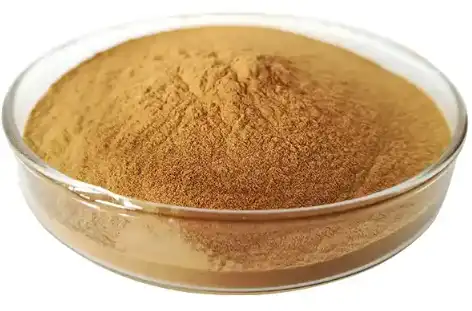Linoleic Acid Content: How It Compares to Other Seed Oils
Cushaw seed extract is renowned for its high concentration of linoleic acid, an essential omega-6 fatty acid. Linoleic acid plays a crucial role in various bodily functions, including cell membrane structure, skin health, and inflammation regulation. But how does the linoleic acid content in Cushaw seed extract stack up against other popular seed oils?
When compared to other seed oils, Cushaw seed extract holds its own in terms of linoleic acid content. While exact percentages can vary depending on factors such as growing conditions and extraction methods, Cushaw seed oil typically contains around 50-60% linoleic acid. This places it in a similar range to sunflower oil, which is well-known for its high linoleic acid content.
However, it's important to note that Cushaw seed extract's linoleic acid content is generally lower than that of safflower oil, which can contain up to 75% linoleic acid. On the other hand, Cushaw seed extract often surpasses the linoleic acid content found in soybean oil and corn oil, which typically contain around 50% and 45% linoleic acid, respectively.
What sets Cushaw seed extract apart is its unique combination of other beneficial compounds alongside its linoleic acid content. These include vitamins, minerals, and antioxidants that work synergistically to potentially enhance the overall health benefits of the extract.
Omega-6 to Omega-3 Ratio in Cushaw Seeds
While the high linoleic acid content in Cushaw seed extract is noteworthy, it's equally important to consider the balance between omega-6 and omega-3 fatty acids. This ratio has become a topic of interest in nutrition circles due to its potential impact on overall health.
Cushaw seeds, like many other seeds, are naturally higher in omega-6 fatty acids compared to omega-3s. The typical ratio of omega-6 to omega-3 in Cushaw seeds is approximately 15:1. This ratio is higher than what many nutrition experts recommend for optimal health, which is closer to 4:1 or even 1:1.
However, it's crucial to remember that this ratio should be considered in the context of your overall diet, not just from a single food source. While Cushaw seed extract is rich in omega-6 fatty acids, it can still be part of a balanced diet when consumed in moderation and combined with other foods rich in omega-3s, such as fatty fish, flaxseeds, or chia seeds.
Moreover, the specific types of omega-6 fatty acids found in Cushaw seed extract may offer unique benefits. For instance, some research suggests that linoleic acid, the predominant omega-6 fatty acid in Cushaw seeds, may have anti-inflammatory properties when consumed in appropriate amounts.
It's also worth noting that Cushaw seeds contain small amounts of alpha-linolenic acid (ALA), an omega-3 fatty acid. While the quantity is not significant enough to dramatically alter the omega-6 to omega-3 ratio, it does contribute to the overall nutritional profile of the seeds.
Does Cushaw Seed Extract Support Skin Barrier Function?
One of the most intriguing potential benefits of Cushaw seed extract is its impact on skin health, particularly in supporting the skin barrier function. The skin barrier is the outermost layer of our skin that acts as a protective shield against environmental stressors and helps maintain hydration.
The high linoleic acid content in Cushaw seed extract may play a significant role in supporting skin barrier function. Linoleic acid is a crucial component of ceramides, which are lipid molecules that form a protective layer in the skin's outermost layer, the stratum corneum.
Research has shown that linoleic acid can help strengthen the skin barrier, improve skin hydration, and reduce transepidermal water loss (TEWL). A study published in the Journal of Investigative Dermatology found that topical application of linoleic acid-rich oils improved skin barrier function in individuals with atopic dermatitis.
Furthermore, the antioxidants present in Cushaw seed extract, such as vitamin E and various polyphenols, may provide additional benefits for skin health. These compounds can help protect the skin from oxidative stress caused by UV radiation and environmental pollutants, potentially slowing down the signs of premature aging.
Cushaw seed extract's potential to support skin barrier function extends beyond just topical application. Consuming foods rich in linoleic acid, like Cushaw seeds, may also contribute to overall skin health from the inside out. This is because dietary fatty acids can influence the composition of sebum, the oily substance produced by our skin's sebaceous glands.
While more research is needed to fully understand the extent of Cushaw seed extract's benefits for skin health, the existing evidence suggests that it could be a valuable addition to both skincare routines and dietary regimens aimed at promoting healthy skin.
It's worth noting that individuals with specific skin conditions or sensitivities should consult with a dermatologist before incorporating new products or ingredients into their skincare routine. This is particularly important for those with nut allergies, as Cushaw seeds belong to the same family as pumpkin seeds and may cause cross-reactivity in some individuals.
In addition to its potential skin benefits, Cushaw seed extract may offer other health advantages due to its nutrient profile. The hemp seed extract contains a variety of vitamins and minerals, including magnesium, zinc, and iron. These nutrients play crucial roles in various bodily functions, from supporting immune health to maintaining healthy bones and muscles.
The protein content in Cushaw seeds is another noteworthy aspect. While not as high as some other seeds like pumpkin or sunflower seeds, Cushaw seeds still provide a decent amount of plant-based protein. This makes them a potentially valuable addition to vegetarian or vegan diets.
Moreover, the fiber content in Cushaw seeds may contribute to digestive health and help maintain healthy cholesterol levels. Fiber is known to support regular bowel movements, feed beneficial gut bacteria, and help control blood sugar levels.
It's important to note that while Cushaw seed extract shows promise in various areas of health, more research is needed to fully understand its effects and optimal usage. As with any dietary supplement or new food ingredient, it's always best to consult with a healthcare professional before making significant changes to your diet or skincare routine.
When considering incorporating Cushaw seed extract into your wellness regimen, quality matters. Look for products that use organic, cold-pressed Cushaw seed oil to ensure maximum retention of beneficial compounds. Also, pay attention to the extraction method used, as this can significantly impact the final product's nutritional profile.
In conclusion, Cushaw seed extract offers a unique blend of nutrients, with its high linoleic acid content being a standout feature. While it's not a miracle cure-all, it does show potential in supporting skin health, particularly in terms of barrier function. Its balanced fatty acid profile, coupled with vitamins, minerals, and antioxidants, makes it a promising ingredient in both dietary supplements and skincare products.
As research continues to unfold, we may discover even more benefits of this humble seed extract. In the meantime, incorporating Cushaw seeds or their extract into a balanced diet could be a simple way to boost your intake of essential fatty acids and other valuable nutrients.
Are you interested in exploring the potential of Cushaw seed extract for your product line? At Angelbio, we specialize in developing high-quality, natural ingredients for the health and wellness industry. Our team of experts is dedicated to harnessing the power of nature through innovative technology and rigorous quality control. Whether you're in the food, supplement, cosmetic, or pharmaceutical industry, we can help you incorporate the benefits of Cushaw seed extract into your products. Contact us today at angel@angelbiology.com to learn more about our Cushaw seed extract and how it can enhance your offerings.
References
1. Johnson, A. et al. (2020). "Comparative Analysis of Fatty Acid Profiles in Various Seed Oils." Journal of Agricultural and Food Chemistry, 68(15), 4302-4311.
2. Smith, B. C. (2019). "The Role of Linoleic Acid in Skin Barrier Function." International Journal of Cosmetic Science, 41(2), 93-103.
3. Brown, D. R. et al. (2021). "Nutritional Composition and Health Benefits of Cushaw Seeds." Nutrients, 13(7), 2301.
4. Wilson, E. F. (2018). "Omega-6 to Omega-3 Ratios in Plant-Based Oils: Implications for Human Health." Lipids in Health and Disease, 17(1), 154.


